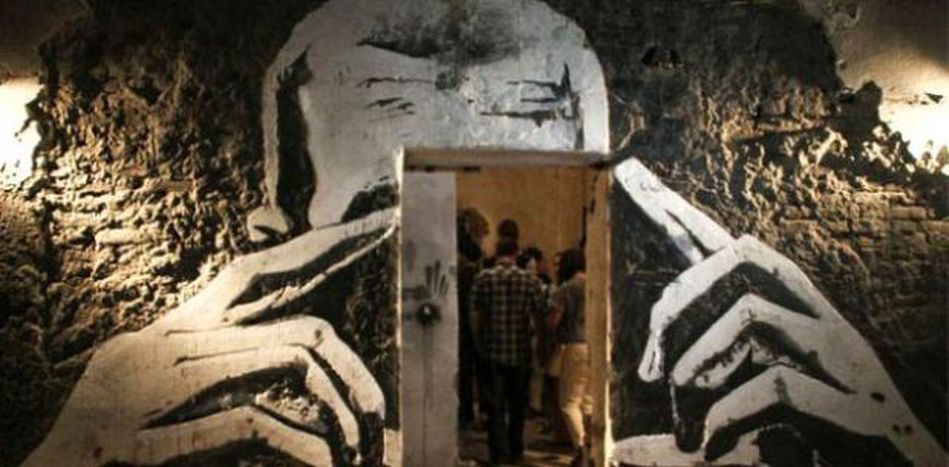
Art – A Haunt in a Transitional Society
Published on
On the 9th of August 2015 an abandon factory was reopened in a small town in central Bosnia and Herzegovina. The reopening, after decades of being forgotten, happend thanks to the work of 3 young guys. They are not entrepreneurs, economists, lawyers but artists. The artists collective HAD had the audacity to open an innovative street art exhibition in Visoko.
On the 9th of August 2015 an abandon factory was reopened in a small town in central Bosnia and Herzegovina. The reopening, after decades of being forgotten, happend thanks to the work of 3 young guys. They are not entrepreneurs, economists, lawyers but artists. The artists collective HAD had the audacity to open an innovative street art exhibition in Visoko.
It was planned to be open just for that one night. It was assumed that only around 40 people will come to see it. It was planned to be just a closing activity for a festival of art and creating called Many men show. The plans backfired. There was more then 200 people on the opening ceremony, the exhibition stayed open for the next 5 nights and had gotten a lot of media attention.
But why?
In a country where culture is marginalized for decades and youth is thought to be obedient, passive and silent it is miraculous to hear about such a successful exhibition, especially if taking into consideration that it took part in a small town. The key to success was a lucky combination of three different characters that managed to work as one. Their cooperation started during an exhibition in the local museum for the European night of the museums on 16th of May 2015. There, Muhamed Hamo Bešlagić - architecture student, Anel Lepić - painter and Damir Sarač - street artist decided to create something together.
The first artwork done by HAD was created on 15 of June 2015. They choose the abandon factory as a place where they can experiment and perfect their vision before taking their art on the streets. However, the more time they spend there, the more they saw the potential of the place. One can even say that the factory shaped their expression as much as they created the factory. „We created new freedom for the three of us. It was not long after we started working there that we realized that we only feel truly free when we are in the factory working. We are not that free when we are walking on the streets in our town“, says Damir.
 Their unique combination of professional skills made them look outside the box when deciding on which technique to use in expressing their visions. And thus walcut was created. Walcut is a new form of street art based on traditional methods of relief and sgraffito fresco technique. Ruined and forgotten walls in this factory were canvases for HAD members and were a trigger to make them want to create a new life by using the hammers, chisel, scalpels and other tools. The concept of their work is dematerialization as a parallel to the whole oppressive system that surrounds us. „The situation in Bosnia and Herzegovina is forcing each individual to escape into their own imaginary world. Everyone is creating their personal world where they can escape. We created ours and invited people in to see it“, states Anel.
Their unique combination of professional skills made them look outside the box when deciding on which technique to use in expressing their visions. And thus walcut was created. Walcut is a new form of street art based on traditional methods of relief and sgraffito fresco technique. Ruined and forgotten walls in this factory were canvases for HAD members and were a trigger to make them want to create a new life by using the hammers, chisel, scalpels and other tools. The concept of their work is dematerialization as a parallel to the whole oppressive system that surrounds us. „The situation in Bosnia and Herzegovina is forcing each individual to escape into their own imaginary world. Everyone is creating their personal world where they can escape. We created ours and invited people in to see it“, states Anel.
 The revolutionary approach is actually showing people that each individual can make a change in any aspect of society and life. Emphasizing that it’s more precious to create together, to stop the alienation that is taking over society. With their work they proved that 3 is stronger then one. Their approach is also based on conceptual art and the desire to enrich the mind of all visitor by addressing all of their senses. To step away from art forms that are purely visual.
The revolutionary approach is actually showing people that each individual can make a change in any aspect of society and life. Emphasizing that it’s more precious to create together, to stop the alienation that is taking over society. With their work they proved that 3 is stronger then one. Their approach is also based on conceptual art and the desire to enrich the mind of all visitor by addressing all of their senses. To step away from art forms that are purely visual.
Their work will not stop here. „The plans for the future are to spread our work to other towns and cities in our country and the region, to work with external walls and make our work visible for everybody“ says Muhamed. The dream is to make the abandoned factory where they first started working into a Modern art gallery, they will pursue it and open it up for everybody if possible.
So is it really a surprise that their exhibition was a success? Or is it just proof that people need and value art even is transitional societies with lower life standards when presented and created with a clear strong message that everyone can understand and co-relate to.
Edited by: Stefan Alijevikj
Original article here



